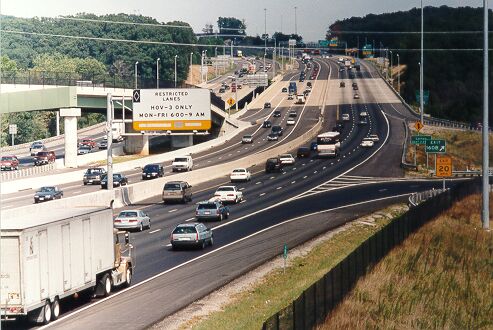
Washington D.C. Area Interstate HOV is a Success
Here's a success story here in the Washington D.C. metropolitan area. A report of Interstate highway HOV facility performance was just released for the Washington D.C. metropolitan area:
1997 Performance of Regional High-Occupancy Vehicle Facilities on Interstate Highways in the Washington Region, An Analysis of Person and Vehicle Volumes and Vehicle Travel Times, May 20, 1998, by Metropolitan Washington Council of Governments (COG), National Capital Region Transportation Planning Board (TPB). Also, the follow-up report 1998 Performance of Regional High-Occupancy Vehicle Facilities on Interstate Highways in the Washington Region, An Analysis of Person and Vehicle Volumes, April 21, 1999.

Recently widened I-95, looking northbound, photo taken August 1997, from VA-123 overpass at Woodbridge, Va. Notice the bridge where I-95 crosses the Occoquan River; it is about 900 feet long, and 11 lanes wide (8 through lanes). Notice the center two-lane roadway. That is a reversible roadway for peak-period HOV-3 vehicles, unrestricted otherwise.
There are three Interstate HOV corridors in operation as of Fall 1997 in the Washington region:
I-95/I-395 (Shirley Highway) in Northern Virginia has a 27-mile barrier-separated HOV-3 reversible 2-lane roadway from south of VA-234 at Dumfries in Prince William County to South Eads Street near the Pentagon in Arlington County. The north end of the reversible roadway divides into 1.5 mile of conventional 4-lane divided express lanes (not HOV presently) that cross the 14th Street Bridge into D.C. and merge into 14th Street and the I-395 Southwest Freeway.
I-66 in Northern Virginia has 18 miles of an HOV-2 inner diamond lane each way from west of VA-234 at Manassas to I-495 Capital Beltway, and 9.6 miles of 2-lane exclusive HOV-2 in peak hours in peak direction, from I-495 to Rosslyn. I-66 from Rosslyn, across the Theodore Roosevelt Bridge, to its terminus in D.C. (about 1.5 mile) does not have HOV facilities. Dulles Airport SOV traffic can use the highway at all times from Rosslyn to the Dulles Airport Access Road. The eastern 3 miles of the DAAR is part of this HOV facility.
I-270 (and I-270 Spur) in Montgomery County, Maryland has 18 miles of an HOV-2 inner diamond lane each way from MD-121 at Clarksburg to I-495 Capital Beltway.
The report is large and very detailed, and a copy would be beneficial for interested parties. Detailed traffic data gathering was performed over a long period of time, and detailed data analysis was performed to produce the report. There are many tables.
Here's some summary excerpts:
"All of these HOV facilities are currently operating at a high level of service, and providing substantial time savings relative to alternative LOV facilities. Expressed on a per-mile basis, the savings range from approximately 0.5 minutes per mile to just over 1.4 minutes per mile. For travelers making use of the full length of these facilities, the savings range from 5 to 12 minutes on I-270, from 17 to 28 minutes on I-66, and from 34 to 39 minutes on I-95/I-395".
"In general, the movement of persons per lane per hour is significantly higher in HOV lanes than in non-HOV lanes. HOV lane person movement ranged from 2,200 to 4,700 per lane per hour while non-HOV lane person movement ranged from 1,400 to 2,000 persons per lane per hour".
"High-occupancy vehicle (HOV) facilities can: increase the number of persons per motor vehicle using a highway over conventional (non-HOV) lanes or roadways; preserve the person-moving capacity of a lane or roadway as demands for transportation capacity increase; enhance bus transit operations; support air quality goals; serve a variety of employment centers in urban and suburban areas; and provide predictable travel times even during periods of high demand for highway capacity".
This is an interesting report. All three of these radial expressways have long-established alignments, over 35 years in each case. Each had HOV facilities added to an existing expressway (except for the special case of multi-modal I-66 inside the Beltway). They are diverse in characteristics, with two expressways (I-95/I-395 and I-66) reaching the D.C. urban core, and one (I-270) with its inbound terminus at the Capital Beltway. The entire I-95/I-395 HOV facility is barrier-separated with direct ramp access. I-270 is entirely a concurrent-flow (diamond lane) design. I-66 is part concurrent-flow and part barrier-separated (by default) HOV design.
My analysis is that future metropolitan growth can lead to even higher person volumes per lane per hour. Originally, the Northern Virginia facilities, I-95/I-395 throughout and I-66 inside the Beltway, had HOV-4 restrictions, and these were eased when it was found that congestion would not result. Heavy peak period HOV traffic increases would lead to increasing the HOV threshold, and obviously an HOV-4 lane near vehicle capacity would carry a lot more people than an HOV-2 lane near vehicle capacity. So these HOV lanes seem to have a bright future. The Dulles Toll Road HOV-2 concurrent-flow (diamond) lanes opened in December 1998, and will bring increased HOV traffic to I-66 east of the DAAR interchange.
There seems to be enough diversity here to conclude that expressway HOV lanes can be a successful development in many large metropolitan areas. The Washington D.C. area has 4.6 million population.
Note about the author agency -
"The
Metropolitan Washington Council of Governments is the regional organization of the Washington area's major local governments and their governing officials. COG works toward solutions to such problems as growth, transportation, inadequate housing, air pollution, water supply, water quality, economic development, and noise, and serves as the regional planning organization for Metropolitan Washington".By Scott M. Kozel,
Roads to the Future